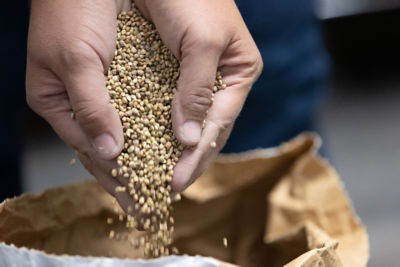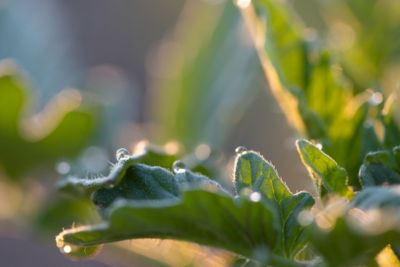Click here to download a PDF version of this spotlight.
» The symbiotic relationship between Rhizobia bacteria and legume plants can help supply the nitrogen needs of legume crops and reduce the need for nitrogen fertilizers.
» Garden beans form nitrogen-fixing root nodules with Rhizobia bacteria, but garden beans are not strong nitrogen fixers compared to other legume crops.
» Applying Rhizobium inoculants to garden beans may or may not result in increased crop growth or yield.
BIOLOGICAL NITROGEN FIXATION
All organisms require the element nitrogen (N) to carry out their biological processes. Nitrogen is an essential component of proteins and many other structural and enzymatic molecules that living organisms use. Nitrogen makes up 78% of the earth’s atmosphere in the form of nitrogen gas (N2 ). However, most organisms cannot use nitrogen in this form. Only a few groups of organisms, including the nitrogenfixing bacteria known as Rhizobia, can convert N2 into biologically useful forms. Rhizobia bacteria establish symbiotic relationships with legume plants and convert N2 into ammonia (NH3 ). They then use NH3 to form organic nitrogen (amino acids and peptones) through a process known as biological nitrogen fixation (BNF). Plants can then take up and use the organic nitrogen produced by the bacteria1,2 Rhizobia reside in the soil, where they can remain dormant for several years. When roots of legume plants are present, the Rhizobia colonize the plant’s root system through the root hairs and cracks in the epidermis. The bacteria enter the root cells and penetrate the root cortex, where they multiply and interact with the plant cells to form root nodules (Figure 1). The root nodules provide a low oxygen environment that allows the enzymes produced by the bacteria to fix nitrogen. The plant supplies the bacteria with food in the form of carbohydrates, and the bacteria provide the plant with nitrogen. The interior of the nodules is pink if nitrogen fixation is taking place (Figure 2).1,2
 Figure 1. (A) Rhizobium root nodules on pea roots. (B) An individual nodule on a bean root. Whitney Cranshaw, Colorado State University, Bugwood.org.
Figure 1. (A) Rhizobium root nodules on pea roots. (B) An individual nodule on a bean root. Whitney Cranshaw, Colorado State University, Bugwood.org.
Approximately one million bacterial cells per seed are needed to form a sufficient number of nodules. The level of Rhizobia in previously inoculated fields may be high enough to provide effective nodulation. Otherwise, coating seeds with the appropriate inoculant can help legume plants to form a sufficient number of nodules to supply nitrogen to the plant.1
 Figure 2. A pink color in the nodule interior indicates that active N-fixation is occurring.
Figure 2. A pink color in the nodule interior indicates that active N-fixation is occurring.
RHIZONIUM AND COMMON BEANS
There are several genera and species of nitrogen-fixing bacteria in the Rhizobia group. There is some specificity in the legume hosts that they will interact with to form nodules and fix nitrogen. Soybean forms nodules with the bacterium Bradyrhizobium japonicum. Pea, faba bean, and lentil form nodules with Rhizobium leguminosarum. Common bean (Phaseolus vulgaris), which includes dry beans and garden beans, can form nodules with several species of Rhizobium, including R. phaseoli, R. etli bv. phaseoli, and R. leguminosarum bv. phaseoli. Some strains of these bacterial species are relatively good nitrogen fixers while others are not, and colonization by poor N-fixers can suppress the level of nodulation with effective N-fixing strains. 2,3,4,5
Common bean is considered a relatively poor symbiotic N-fixer compared to other legume species. On average, common bean plants obtain about 39% of their N supply from BNF. By comparison, faba bean gets up to 75% of its N from BNF, and soybean, pea, and lentil get from 62 to 94% of their N from BNF.6 Efforts to reduce the use of inorganic N fertilizers could be helped by increasing the level of BNF occurring with common bean varieties. Treating bean seeds with an inoculum of capable nitrogen-fixing Rhizobium strains that can compete with poor N-fixing strains in the soil can help increase the level of BNF supplied N on common bean. Inoculation of bean seeds with capable N-fixing strains can also be used to establish populations of N-fixing Rhizobia in soils with few or no Rhizobium bacteria present.5,6
INOCULATION AND YIELD
The Rhizobium inoculants have been used to enhance the level of nodulation and the rate of N-fixation on legume crops in agricultural fields. In soils with no or low levels of natural Rhizobia, inoculation with Rhizobia species often results in enhanced growth of the crop and increased yield potential.4 However, the levels of BNF are affected by several factors, including the level of N in the soil, the condition of the host plant, soil temperatures that are outside of the optimal range for nodule formation and N-fixation, excessive soil moisture or drought conditions, high soil salinity and high soil pH, and a deficiency of phosphorus in the soil.2,3
Bacterial inoculants are often infused in finely ground peat or other carrier materials and are usually applied as seed treatments before planting (Figure 3). Inoculants are living organisms, so following the manufacturer’s directions for storage, handling, and application is important. Inoculants should be stored in a cool, dry place, such as a refrigerator, and inoculants should be used before the indicated expiration date to ensure the viability of the bacteria.1
 Figure 3. Green bean seeds (left) treated with Rhizobium inoculum (top). Non-treated seeds are on the right.
Figure 3. Green bean seeds (left) treated with Rhizobium inoculum (top). Non-treated seeds are on the right.
Unfortunately, there are not many studies on the effects of Rhizobium inoculation on growth and yield in garden bean (green bean), but there are several published studies on the effects of Rhizobium inoculation on dry beans, which are also varieties of Phaseolus vulgaris. In a New Zealand study, two dry bean cultivars were compared for their responses to Rhizobium inoculation, nitrogen fertilizer treatment, and irrigation. Two strains of Rhizobium were used in the first trial. However, no root nodules formed on either bean variety with either strain. In a second trial, five different strains of inoculant were used. In greenhouse tests, 7 to 441 nodules per plant formed by 51 days after sowing, depending on inoculant strain and bean variety. In field trials, one to 70 nodules formed per plant. The interior color of the nodules was pink in more than 80% of these nodules, indicating that active nitrogen fixation was occurring. However, the inoculum treatments had no significant effect on yield for either cultivar over the two seasons of the study. DNA analysis of the Rhizobium bacteria isolated from the nodules showed that none of the nodules contained the strains of bacteria that were used to inoculate the seed. This indicates that the nodulation was caused by other strains of Rhizobium already present in the soil at planting, which may explain the lack of growth response by the host.7 A study on the effects of Rhizobium on pinto and kidney beans in North Dakota also showed that inoculation did not result in increases in yield, and in some cases yields in the inoculated plots were lower than in the non-inoculated plots.6 Other studies have shown that native Rhizobium strains in the soil that are well adapted to a particular location can outcompete non-native strains that are used to inoculate bean seeds resulting in lower levels of BNF. One study found that this problem could be overcome by inoculating with local strains adapted to the location and screened for their ability to fix nitrogen in nodules on common bean plants.5
At present, the usefulness of treating garden beans with Rhizobium inoculum is questionable. It may be possible to develop strains of Rhizobium species that can compete with local strains and form root nodules with garden beans that provide substantial amounts of N to the crop and reduce the need for the application of N fertilizers. At present, there is no strong evidence to indicate that inoculating garden beans will result in subtantially improved crop growth or yield levels in commercial production systems.
SOURCES
1 Fudge, R. 2022. Inoculating garden legumes. University of Minnesota Extension. https://extension.umn.edu/yard-and-garden-news/inoculating-garden-legumes.
2 Biddle, A. 2017. Peas and beans. CABI, Boston. Ppg. 20-24.
3 Martínez-Romero, E. 2003. Diversity of Rhizobium-Phaseolus vulgaris symbiosis: overview and perspectives. Plant and Soil 252, 11–23.
4 Morad, M., Sara, S., Alireza, E., Reza, C. M., & Mohammad, D. 2013. Effects of seed inoculation by Rhizobium strains on yield and yield components in common bean cultivars (Phaseolus vulgaris L.). Int. J. Biosci, 3, 134-141.
5 Pastor-Bueis, R., Sánchez-Cañizares, C., James, E. K., & González-Andrés, F. 2019. Formulation of a highly effective inoculant for common bean based on an autochthonous elite strain of Rhizobium leguminosarum bv. phaseoli, and genomic-based insights into its agronomic performance. Frontiers in microbiology, 10, 2724.
6 Sanyal, D., Osorno, J. M., and Chatterjee, A. 2020. Influence of Rhizobium inoculation on dry bean yield and symbiotic nitrogen fixation potential. Journal of Plant Nutrition 43: 798-810.
7 Kellman, A. 2008. Rhizobium inoculation, cultivar and management effects on the growth, development and yield of common bean (Phaseolus vulgaris L.). PhD Dissertation, Lincoln University, Canterbury, New Zealand.
8 Franzen, D. 2017. Fertilizing Pinto, Navy and other dry edible beans. North Dakota State University Agricultural Extension Publication Fargo: SF-720.
Websites verified 9/20/2022
ADDITIONAL INFORMATION
For additional agronomic information, please contact your local seed representative.
Performance may vary from location to location and from year to year, as local growing, soil and weather conditions may vary. Growers should evaluate data from multiple locations and years whenever possible and should consider the impacts of these conditions on the grower’s fields. The recommendations in this article are based upon information obtained from the cited sources and should be used as a quick reference for information about vegetable production. The content of this article should not be substituted for the professional opinion of a producer, grower, agronomist, pathologist and similar professional dealing with vegetable crops.
BAYER GROUP DOES NOT WARRANT THE ACCURACY OF ANY INFORMATION OR TECHNICAL ADVICE PROVIDED HEREIN AND DISCLAIMS ALL LIABILITY FOR ANY CLAIM INVOLVING SUCH INFORMATION OR ADVICE. 5113_73850 Published 10/04/2022
Bayer, Bayer Cross, Seminis & Leaf Design®, and Seminis® are registered trademarks of Bayer Group. All other trademarks are property of their respective owners. © 2022 Bayer Group. All rights reserved.




